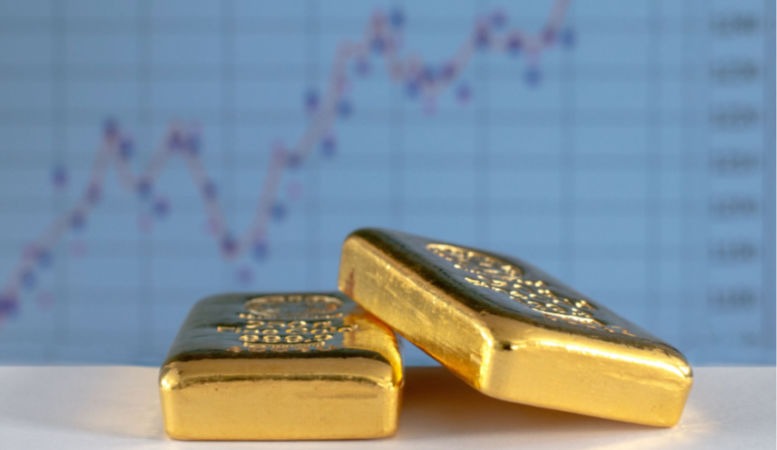Table of Contents
Whether you’re looking to invest in physical gold or use this precious metal to make jewelry, you likely wonder what affects gold prices. Predicting the price of gold isn’t as easy as tracking supply and demand. Several factors influence the price of gold, making price predictions tricky.
This guide explains the most common factors affecting the value of gold and how these trends have caused prices to rise and fall throughout history in the United States.
Please note that although we can point to historical trends and likelihoods, predicting the price of gold never turns out as straightforward as it seems on paper. These trends do not guarantee the same results in similar future situations, and trends do not guarantee future price behavior.
Factors Affecting Gold Prices
Predicting gold prices requires more than just analyzing supply and demand, although these factors certainly play crucial roles. Let’s look at the primary factors affecting gold to understand why prices may rise and fall.
Supply and Demand
The basic theory of supply and demand economics affects gold prices like the costs of other goods and services. When demand increases and supply decreases, prices go up. On the other hand, prices decrease when supply soars and demand decreases.
According to the World Gold Council, about half of the demand for gold primarily came from the jewelry industry in 2019, so you must consider gold jewelry when predicting gold prices.
Other industries affecting gold demand include precision medical devices and electronics. Investments and government central banks also affect demand, which we’ll discuss more thoroughly below.
The Value of the US Dollar
Gold is dollar-denominated, which means currency fluctuations in the US dollar directly affect per-ounce gold rates. The dollar’s value and gold tend to have an inverse relationship: when the dollar falls, gold rises, and vice versa. Collectors and investors tend to purchase more gold when the dollar is weaker, and because they can get more for their money, which raises demand and the price of gold.
Many experts recognized this currency devaluation trend in 2016, when a weakened US dollar resulted in the highest demand for gold in about seven years.
Gold Mining and Production

Gold prices rise as the costs of gold mining and production go up, which they continue to do as miners dig deeper and longer to find high-quality gold. As mining efforts become complicated by more significant risks to miners and the environment, production gets more expensive, causing this precious metal to become increasingly scarce. The price of gold tends to rise in response to these increased risks and the fact that it takes a constantly increasing effort to mine less gold.
Gold Exchange-traded Funds (ETFs)
Like mutual funds, exchange-traded funds (ETFs) allow investors to purchase shares of assets without incurring the risk of investing directly. Gold ETFs buy physical gold, sell shares to individual investors, and provide fund management services to reap the highest possible returns for their shareholders.
These funds can affect gold prices due to fluctuating investor interest—when ETFs account for a large part of gold demand, per-ounce prices tend to increase. Gold ETFs and other investment vehicles account for a significant portion of demand. According to the World Gold Council, gold investments made up 29% of demand in 2019.
Central Banks
The central banks of countries worldwide also affect the value of gold depending on how much they purchase for their gold reserves. Since the US stopped using the gold standard, other countries have begun transferring their government reserves from paper money into gold, increasing the demand and causing gold prices to increase.
Interest Rates
Investors are constantly weighing risk versus reward. When interest rates decrease, investors look to alternative assets like precious metals and other commodities to get higher returns.
The Federal Reserve sets interest rates and provides commentary on current trends. Gold investors track these trends and buy and sell gold according to the current opportunity cost—that is, the potential gains of other options lost when choosing one alternative over another. When the Federal Reserve indicates high interest rates, gold prices tend to fall, and if they imply a decrease or no change in interest rates, the gold price rises.
Economic Fluctuations
Investors don’t look for “safe haven” opportunities when the economy seems stable. Times of economic growth tend to witness lower gold prices because inflation and other economic data influence interest rates, which affect the opportunity cost of investing in gold. In contrast, when the economy struggles with higher unemployment, low GDP, and weak job growth, the price of gold may increase.
To see this factor in action, skip down this article to the section on historical gold hikes. The three gold bull markets (or periods of significant price increase) the US has experienced in the past five decades offer excellent examples of how economic uncertainty has a positive impact on gold’s value.
Wealth Protection (Hedging)
During times of economic uncertainty, people turn to what they consider safe investment options to protect their wealth. Gold, a popular hedging tool, has held relatively stable value for thousands of years. People wanting to protect themselves against high inflation and economic downturns invest in gold, which increases investment demand and causes the per-ounce gold price to rise.
Many people turn to gold when hedging against inflation and uncertainty because it’s a physical commodity, and they consider it safer than investing in intangible assets. Investors have dubbed gold a “safe haven” asset because it tends to maintain its value over long periods despite price fluctuations.
Reasons for Past Gold Price Hikes

One method of understanding current and future gold prices relies on tracking price hikes throughout history. Many experts call these periods of significant price increases “bull markets,” and there have been three since 1969. Let’s look at each to understand what positively impacted the prices of this highly sought-after commodity.
Before we dive into the significant changes that occurred in 1971, let’s review some history.
Gold Price and Ownership From 1933 to 1971
According to a Visual Capitalist article, when the stock market crashed in 1929, people began abandoning the US dollar and redeeming their paper currency for gold. This resulted in a loss of monetary supply in the US economy and threatened to drain the country’s gold reserves. In response, Congress passed the Gold Reserve Act in 1934, which made it illegal for private citizens to own gold.
By 1969, gold was priced at $42 per ounce (which may seem low but doesn’t account for inflation). President Nixon abandoned the US gold standard in 1971, when he instructed the Federal Reserve to stop honoring gold’s value at a fixed rate. No longer backed by a commodity, the US dollar joined the fiat currencies group, which has value backed by an authority (like the US government) rather than a commodity.
Gold Prices From 1971 to 1980
Investors could buy gold again after President Ford relegalized private gold ownership in 1974. The US economy was experiencing high inflation and unemployment, leading to economic stagnation and uncertainty. By 1980, gold had risen to $678 per ounce, a 684% increase since 1969 and the highest gold price until the next bull market began in 2006.
Gold Prices in 2011
Gold prices began to rise again following 9/11 as uncertainty increased demand. In 2008, the US fell into a recession following the global financial crisis (GFC), and concerns about debt drove prices to a new height of $1,825 per ounce by August 2011.
Gold Prices in 2020
Prices decreased following the 2011 hike as the world recovered from the 2008 GFC, but they began to rise again in 2016. Since then, uncertainty has taken hold due to several factors, including the COVID-19 pandemic, and the price peaked in 2020 at $1,751 per ounce.
How Do Gold Investments Affect Gold Prices?
Investing affects gold prices as investors purchase physical gold and other commodities and buy ETF shares. Demand for gold investments tends to result in increased gold costs. Various factors increase the investing demand, including interest rates, economic data, and Federal Reserve policies.
Is Gold Still a Good Investment?

Many investors use precious metal investments to diversify their portfolios and still consider gold an excellent investment. Despite its price fluctuations, gold is a relatively stable commodity with a general increase in price through the decades. It continues to experience high demand worldwide and remains a constant among popular financial instruments to hedge against inflation and other economic hardships.
Key Takeaways
We understand that we just gave you a lot of information. Here’s a short list of key takeaways on what affects the value of gold:
- High demand and low supply tend to raise the per-ounce price.
- Prices increase when the dollar’s strength decreases.
- Prices increase as mining efforts become more expensive and dangerous.
- High investment demand tends to increase the per-ounce rate.
- As central banks buy more of this commodity, prices increase.
- Higher interest rates tend to lower the cost.
- Economic hardships tend to cause prices to rise.
- Increased hedging for wealth protection also raises prices.
We can track these trends throughout history by analyzing past bull markets.
If you’re tracking prices for this coveted commodity, be sure to consider all of the above factors for the most accurate prediction of future rates. To learn more about the rates within the past 18 months, check out this article, in which we briefly discuss predictions for the future price of this commodity.
Back Your IRA or 401K With Gold
At Oxford Group, we believe everyone deserves the opportunity to own gold and other precious metals, so we created a precious metal firm dedicated to providing investors with all the information they need to make informed purchases. Our clients love working with our knowledgeable and helpful team. Visit our reviews page to learn what our customers have said about us.
Make Oxford Gold Group your preferred precious metal firm. We can help you protect your IRA with physical gold and purchase gold bullion and coins. We also work with silver, platinum, and palladium coins and bars. Get in touch to discuss your options for buying gold and other precious metals today.
You can contact us online or call us at (833) 600-GOLD to get started today.








